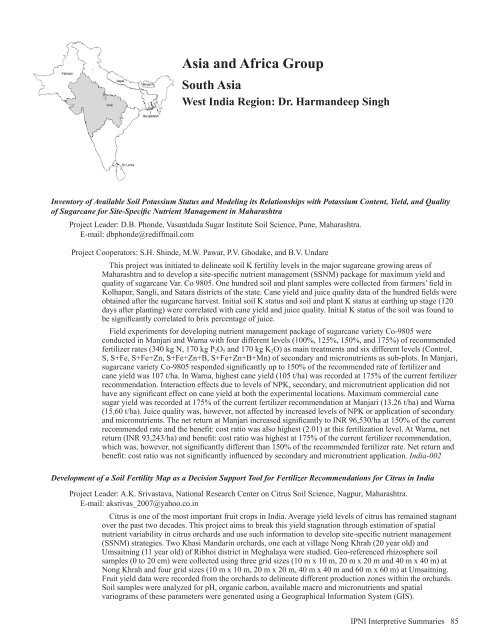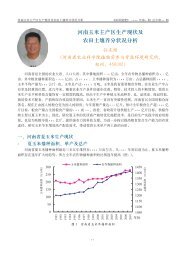Americas and Oceania Group - International Plant Nutrition Institute
Americas and Oceania Group - International Plant Nutrition Institute
Americas and Oceania Group - International Plant Nutrition Institute
Create successful ePaper yourself
Turn your PDF publications into a flip-book with our unique Google optimized e-Paper software.
Asia <strong>and</strong> Africa <strong>Group</strong><br />
South Asia<br />
West India Region: Dr. Harm<strong>and</strong>eep Singh<br />
Inventory of Available Soil Potassium Status <strong>and</strong> Modeling its Relationships with Potassium Content, Yield, <strong>and</strong> Quality<br />
of Sugarcane for Site-Specific Nutrient Management in Maharashtra<br />
Project Leader: D.B. Phonde, Vasantdada Sugar <strong>Institute</strong> Soil Science, Pune, Maharashtra.<br />
E-mail: dbphonde@rediffmail.com<br />
Project Cooperators: S.H. Shinde, M.W. Pawar, P.V. Ghodake, <strong>and</strong> B.V. Undare<br />
This project was initiated to delineate soil K fertility levels in the major sugarcane growing areas of<br />
Maharashtra <strong>and</strong> to develop a site-specific nutrient management (SSNM) package for maximum yield <strong>and</strong><br />
quality of sugarcane Var. Co 9805. One hundred soil <strong>and</strong> plant samples were collected from farmers’ field in<br />
Kolhapur, Sangli, <strong>and</strong> Satara districts of the state. Cane yield <strong>and</strong> juice quality data of the hundred fields were<br />
obtained after the sugarcane harvest. Initial soil K status <strong>and</strong> soil <strong>and</strong> plant K status at earthing up stage (120<br />
days after planting) were correlated with cane yield <strong>and</strong> juice quality. Initial K status of the soil was found to<br />
be significantly correlated to brix percentage of juice.<br />
Field experiments for developing nutrient management package of sugarcane variety Co-9805 were<br />
conducted in Manjari <strong>and</strong> Warna with four different levels (100%, 125%, 150%, <strong>and</strong> 175%) of recommended<br />
fertilizer rates (340 kg N, 170 kg P 2 O 5 <strong>and</strong> 170 kg K 2 O) as main treatments <strong>and</strong> six different levels (Control,<br />
S, S+Fe, S+Fe+Zn, S+Fe+Zn+B, S+Fe+Zn+B+Mn) of secondary <strong>and</strong> micronutrients as sub-plots. In Manjari,<br />
sugarcane variety Co-9805 responded significantly up to 150% of the recommended rate of fertilizer <strong>and</strong><br />
cane yield was 107 t/ha. In Warna, highest cane yield (105 t/ha) was recorded at 175% of the current fertilizer<br />
recommendation. Interaction effects due to levels of NPK, secondary, <strong>and</strong> micronutrient application did not<br />
have any significant effect on cane yield at both the experimental locations. Maximum commercial cane<br />
sugar yield was recorded at 175% of the current fertilizer recommendation at Manjari (13.26 t/ha) <strong>and</strong> Warna<br />
(15.60 t/ha). Juice quality was, however, not affected by increased levels of NPK or application of secondary<br />
<strong>and</strong> micronutrients. The net return at Manjari increased significantly to INR 96,530/ha at 150% of the current<br />
recommended rate <strong>and</strong> the benefit: cost ratio was also highest (2.01) at this fertilization level. At Warna, net<br />
return (INR 93,243/ha) <strong>and</strong> benefit: cost ratio was highest at 175% of the current fertilizer recommendation,<br />
which was, however, not significantly different than 150% of the recommended fertilizer rate. Net return <strong>and</strong><br />
benefit: cost ratio was not significantly influenced by secondary <strong>and</strong> micronutrient application. India-002<br />
Development of a Soil Fertility Map as a Decision Support Tool for Fertilizer Recommendations for Citrus in India<br />
Project Leader: A.K. Srivastava, National Research Center on Citrus Soil Science, Nagpur, Maharashtra.<br />
E-mail: aksrivas_2007@yahoo.co.in<br />
Citrus is one of the most important fruit crops in India. Average yield levels of citrus has remained stagnant<br />
over the past two decades. This project aims to break this yield stagnation through estimation of spatial<br />
nutrient variability in citrus orchards <strong>and</strong> use such information to develop site-specific nutrient management<br />
(SSNM) strategies. Two Khasi M<strong>and</strong>arin orchards, one each at village Nong Khrah (20 year old) <strong>and</strong><br />
Umsaitning (11 year old) of Ribhoi district in Meghalaya were studied. Geo-referenced rhizosphere soil<br />
samples (0 to 20 cm) were collected using three grid sizes (10 m x 10 m, 20 m x 20 m <strong>and</strong> 40 m x 40 m) at<br />
Nong Khrah <strong>and</strong> four grid sizes (10 m x 10 m, 20 m x 20 m, 40 m x 40 m <strong>and</strong> 60 m x 60 m) at Umsaitning.<br />
Fruit yield data were recorded from the orchards to delineate different production zones within the orchards.<br />
Soil samples were analyzed for pH, organic carbon, available macro <strong>and</strong> micronutrients <strong>and</strong> spatial<br />
variograms of these parameters were generated using a Geographical Information System (GIS).<br />
IPNI Interpretive Summaries 85

















